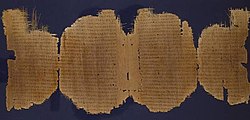| New Testament manuscript | |
 Folios 13-14 with part of the Gospel of Luke | |
| Name | P. Chester Beatty I |
|---|---|
| Sign | 𝔓45 |
| Text | Gospels, Acts |
| Date | c. 250 |
| Script | Greek |
| Found | Egypt |
| Now at | Chester Beatty Library |
| Cite | F.G. Kenyon, The Chester Beatty Biblical Papyri (London: E. Walker), 1933 |
| Size | 30 leaves; 10 in x 8 in |
| Type | eclectic text-type |
| Category | I |
Papyrus 45 (P. Chester Beatty I), designated by siglum 𝔓45 in the Gregory-Aland numbering of New Testament manuscripts, is an early Greek New Testament manuscript written on papyrus, and is one of the manuscripts comprising the Chester Beatty Papyri, a group of early Christian manuscripts discovered in the 1930s, and purchased by business man and philanthropist, Alfred Chester Beatty.[1] Beatty purchased the manuscript in the 1930s from an Egyptian book dealer, and it was subsequently published in The Chester Beatty Biblical Papyri, Descriptions and Texts of Twelve Manuscripts on Papyrus of the Greek Bible by palaeographer, biblical and classical scholar Frederic G. Kenyon in 1933.[1]: 121, 118 Manuscripts among the Chester Beatty Papyri have had several places of discovery associated with them, the most likely being the Faiyum in Egypt (the dry sands of Egypt have been a haven for finding very early manuscripts since the late 1800s).[2] Using the study of comparative writing styles (palaeography), it has been dated to the early 3rd century CE.[3] This therefore makes it the earliest example of not only the four Gospels contained in one volume, but also the Acts of the Apostles.[1]: 134 It contains verses in fragmentary form from the texts of Matthew chapters 20–21 and 25–26; Mark chapters 4–9 and 11–12; Luke chapters 6–7 and 9–14; John chapters 4–5 and 10–11; and Acts chapters 4–17.[4]: vii
The manuscript is currently housed at the Chester Beatty Library, Dublin, Ireland, except for one leaf containing Matt. 25:41–26:39, which is in the Papyrus Collection of the Austrian National Library in Vienna (Pap. Vindob. G. 31974).[5][6]: 109
- ^ a b c Nongbri, Brent (2018). God's Library: The Archaeology of the Earliest Christian Manuscripts. New Haven; London: Yale University Press. pp. 116–122. ISBN 978-0-300-21541-0.
- ^ See main Chester Beatty Papyri page for full info.
- ^ Kenyon, Frederic G. (1933). The Chester Beatty Biblical Papyri, Descriptions and Texts of Twelve Manuscripts on Papyrus of the Greek Bible, Fasciculus I, General Introduction. Emery Walker Ltd. p. x.
- ^ Kenyon, Frederic G. (1933). The Chester Beatty Biblical Papyri, Descriptions and Texts of Twelve Manuscripts on Papyrus of the Greek Bible, Fasciculus II, The Gospels and Acts, Text. Emery Walker Ltd.
- ^ "Liste Handschriften". Münster: Institute for New Testament Textual Research. Retrieved 26 August 2011.
- ^ Aland, Kurt; Aland, Barbara (1989). The Text of the New Testament: An Introduction to the Critical Editions and to the Theory and Practice of Modern Textual Criticism. Erroll F. Rhodes (trans.). Stuttgart: Eerdmans. ISBN 3-438-06011-6.